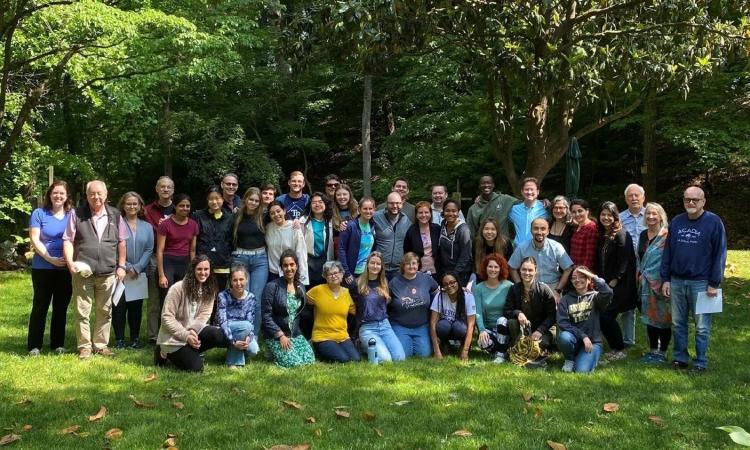Media contact: Dan Watson
(text and background only visible when logged in)
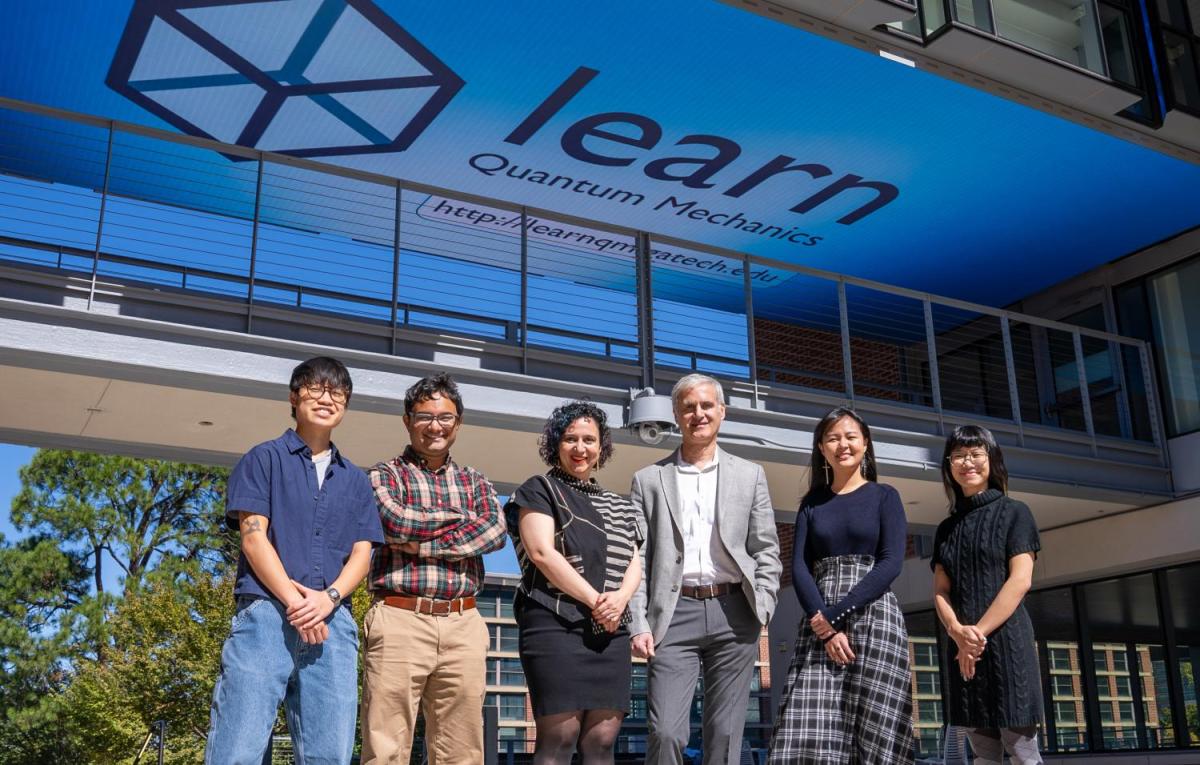
A portion of the interdisciplinary team in front of the Georgia Tech Media Bridge displaying the interactive visualizations and games developed to help students better understand quantum mechanics and semiconductor physics.
(text and background only visible when logged in)
What do electrons look like? How do eclectic currents flow in a circuit? How do electronic devices like transistors work?
These seemingly innocent questions open a Pandora’s box of complexities that lie at the heart of semiconductors, microelectronics, and quantum physics.
To grasp how this all works conceptually, you need to accept mathematical fundamentals and use a little imagination because electrons are so minuscule that the physics we know and understand don’t apply to them.
These contradictions and abstract concepts come to a head in ECE 3040: Microelectronic Circuits. Notorious for its difficulty, few courses offered by the Georgia Tech School of Electrical and Computer Engineering challenge students as much as ECE 3040.
The course can also potentially deter students from pursuing careers in semiconductors and microelectronics, according to Professor Azad Naeemi.
“These types of courses are heavy on math and when you ask students about conceptual questions, even the ones who can mathematically solve the problem, they often struggle to qualitatively explain what is happening because we don’t experience electrons and quantum effects in everyday life,” he said.
As computer engineering undergraduate student Barnabe Marty puts it, “device physics are highly unintuitive.”
A Decade’s Worth of Interdisciplinary Collaboration
For the past ten years, Naeemi and a team of researchers and students have been dedicated to improving the teaching of quantum and semiconductor physics through the creation of interactive visualization tools and computer games.
In September, they received a significant boost from the National Science Foundation (NSF). Their NSF project, “Experiential Learning for Semiconductor Physics and Devices,” was funded to expand the educational simulation tools developed at Georgia Tech, Arizona State, and Purdue. Additionally, the team will research design elements to improve effectiveness and implement comprehensive measurement strategies.
The interdisciplinary team also includes experts and students from the University of Washington, Kennesaw State University, and Hampton University, with diverse backgrounds in engineering, digital media, information science, and engineering education.
The journey to address these educational challenges began around 2012, when Professor Naeemi teamed up with Associate Professor Nassim Parvin from the Georgia Tech School of Literature, Media, and Communication. Parvin, who is now an associate professor at the University of Washington Information School, brought a unique perspective to the project.
With a background in electrical engineering, she was familiar with the basic concepts but also shared many of the frustrations that students faced.
“I too had many of the misconceptions that we are trying to address in the visualizations and would generally fall back on the mathematical formulas without grasping the phenomena conceptually,” Parvin said.
When Naeemi explained the visualization problem to Parvin, she was fascinated by the possibility of creating learning environments that could help students experience what it would be like to be in a quantum world.
“The challenge facing many classrooms, especially in higher education, is still based on the idea of education as information transmission,” Parvin said. “The success of our approach depends on an active re-imagining of how these courses are conceived and taught."
This led to the idea of designing a series of computer games.
The digital medium was particularly appealing because it allows students to simulate time-based phenomena and showcase probabilistic concepts through repetition, much like performing many experiments.
“In quantum physics, a lot of things are based on probability, and the only way that you can experience probability is if you repeat the same experiment many, many times,” Naeemi said. “A game usually involves repeated events, allowing players to really experience these probabilities.”
(text and background only visible when logged in)
LearnQM Games and Visualizations
Psi and Delta
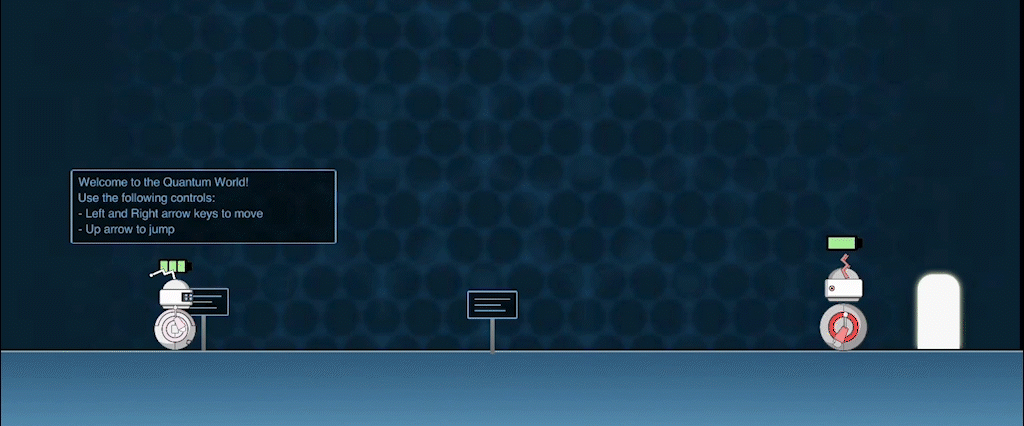
Psi and Delta is a collaborative classroom videogame that enables students to experience the world of the very small, together. It draws on the theoretical foundations of learning as a social activity and incorporates positively interdependent collaboration where multiple students have to understand the concepts to pass each level.
(text and background only visible when logged in)
Particle in a Box
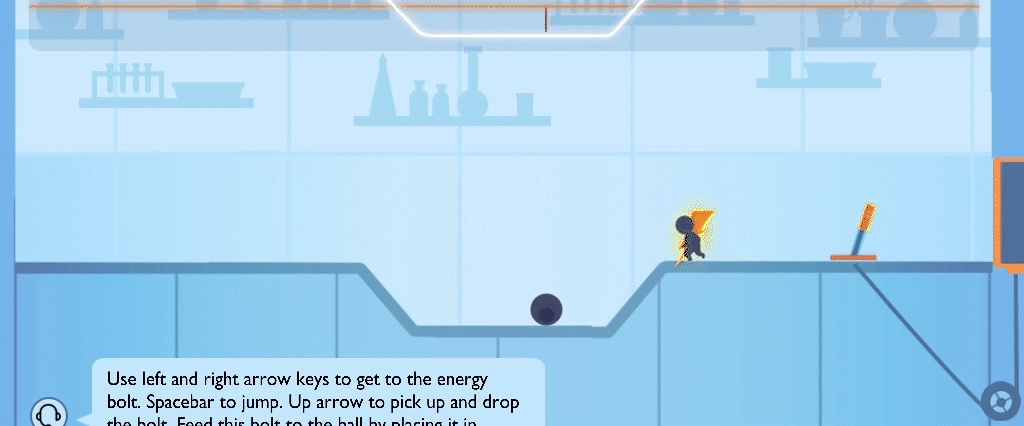
Particle in a Box is a single-player game based on the principles of quantum mechanics. It integrates game design, scientific visualization, and quantum physics to offer a unique experience. Players can compare classical and quantum environments, creating a virtual space that helps students engage with and become familiar with quantum mechanics concepts.
(text and background only visible when logged in)
P-N Junction Visualization
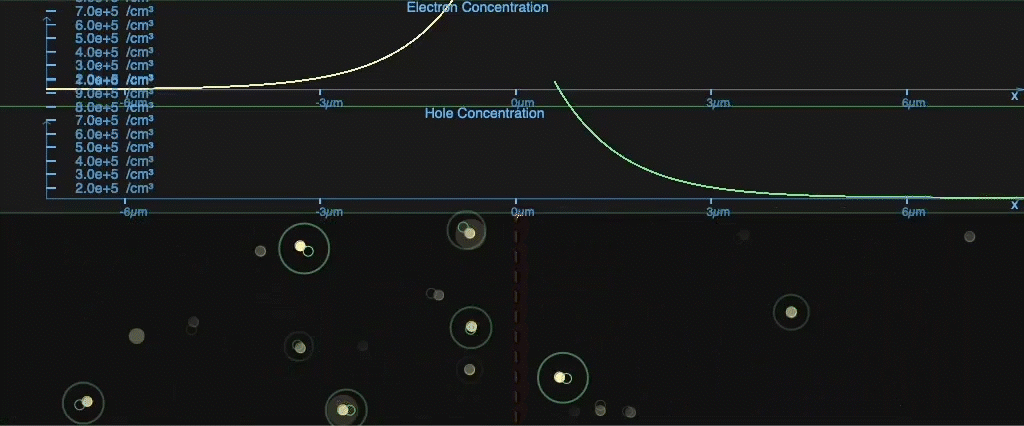
Watch as electrons and holes dance across the junction, creating a dynamic equilibrium that powers countless electronic devices. This engaging tool allows students to manipulate voltage and observe real-time changes in the depletion region, current flow, and electric field.
(text and background only visible when logged in)
(text and background only visible when logged in)
(text and background only visible when logged in)
Promising Initial Results
The initial project, which involved creating a computer game governed by the laws of quantum mechanics, proved to be a success. It combined the right balance of expertise from digital media for engaging visualizations, game design for interactive learning experiences, quantum physics for scientific accuracy, semiconductor physics for practical applications, and educational research for evaluating effectiveness.
The project won numerous awards including the IEEE Solid-State Circuits Society James Meindl Innovators Award, the Georgia Tech Outstanding Innovative Use of Educational Technology Award, and a Student's Choice Award at Serious Games Showcase.
It was even exhibited in Washington D.C. during the ACCelerate: ACC Smithsonian Creativity and Innovation Festival at the Smithsonian National Museum of American History in May 2019 where hundreds of visitors played the game.
“I was especially impressed by the insightful and imaginative questions that school-aged children asked, often revealing perspectives and ideas that adults might overlook,” Parvin said.
Building on this success, the team decided to look deeper into semiconductor education. They developed interactive visualizations and games that start with fundamental concepts, such as the hydrogen atom, and progressively build up to more complex ideas like silicon lattices and semiconductor devices.
Expanding to the Classroom
The design process for the interactive tools involves extensive brainstorming and ideation, gathering examples from various domains, and moving through multiple iterations of concept designs and quick testing.
“I knew very little about semiconductor physics when I joined the team,” said Ren Zheng, a master’s student in digital media who is one of the project’s design leads. "There's a weaving back and forth between learning the concepts, translating them into visualizations, and learning through that translation.”
“After I've written a lot of code, we may realize it's not the best way to represent something,” Zheng added. “That informs changes we make to the design. The mistakes are a big part of the process.”
The goal is to create tools that not only convey complex concepts but also encourage collaboration and critical thinking, according to Parvin.
“The point, at the end of the day, is not that they memorize information but that they approach questions in the ways that scientists do,” she said.
To evaluate the effectiveness of the tools, the team conducted preliminary studies with around 30 students. The students were divided into experimental and control groups, with the experimental group using the interactive visualizations.
The results were promising.
While both groups showed similar levels of learning, the experimental group reported significantly higher confidence and comfort with the material.
“The visualizations were great in helping me understand the logic behind all the mathematical derivations and models, as well as the connections between different areas of physics,” said Marty, the computer engineering undergraduate student.
(text and background only visible when logged in)
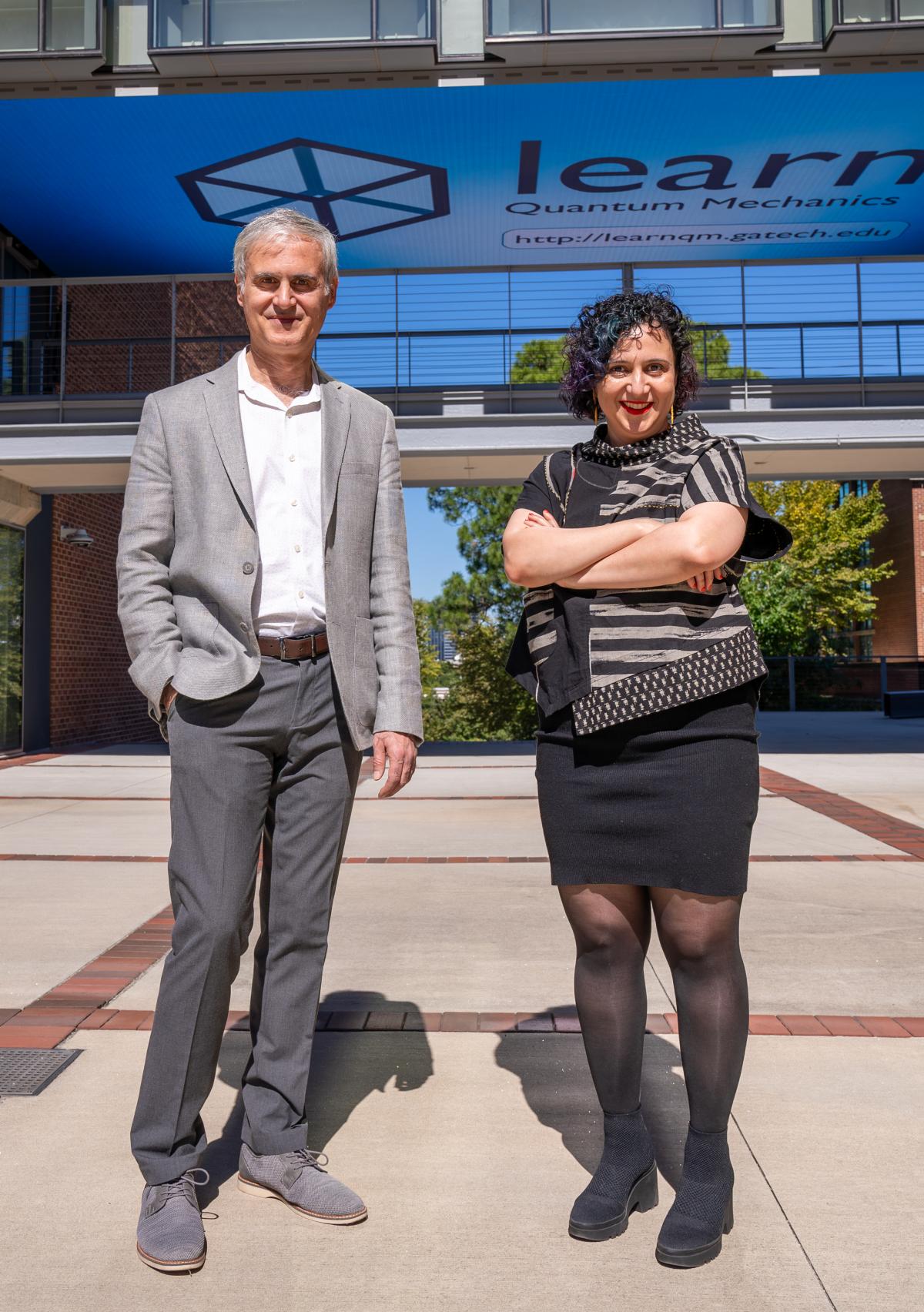
Professors Azad Naeemi and Nassim Parvin have been working on the visualization and gaming educational tools for over a decade.
Seizing the Moment
Given the increasing focus on microelectronics workforce development and the CHIPS Act, Naeemi believes now is the perfect time to evaluate and grow the program.
Through the NSF proposal, the team will vigorously research the effectiveness of the visualizations and games at scale, aiming to significantly improve students’ comfort with learning about the quantum world and to ultimately prepare them for related careers.
As Naeemi emphasized, “If you suddenly saw everything falling upwards tomorrow, it would seem really crazy at first. But if you saw it every day, you’d eventually get used to it. Similarly, with these visualizations, we can help students get used to these difficult concepts, and over time, they won’t seem so crazy.”
Explore the team’s entire suite of interactive visualizations and computer games at learnqm.gatech.edu.
Pictured in the top photo are Ren Zheng (MS-Digital Media), Aditya Anupam (PhD-Digital Media currently at Everi Holdings Inc.), Nassim Parvin (Associate Professor at the University of Washington iSchool), Azad Naemmi (Professor in the Georgia Tech School of Electrical and Computer Engineering), Audrey Chung (MS-Digital Media), and Marie Ow (MS-Digital Media).
(text and background only visible when logged in)
Related Content
Personalized Indoor Accessibility App Project for Persons with Disabilities Receives NSF Boost
Professor Patricio Vela joins the MABLE project aiming to enhance indoor accessibility for persons with disabilities by creating a digital app with enhanced maps that help users navigate based on their specific needs.
(text and background only visible when logged in)
Silent Retreat Program Helping Students to Quiet the Noise of Busy Semesters
Professor John Cressler has participated in silent retreats for over 25 years, touting the mental benefits of time away from the outside world. Now he’s leading students through the journey (and benefits) of silence.
(text and background only visible when logged in)

